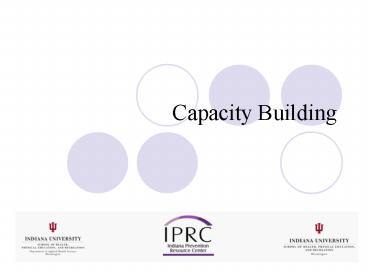Capacity Building - PowerPoint PPT Presentation
1 / 14
Title:
Capacity Building
Description:
Shows a plan for developing capacity among prevention partners. Describes and identifies ... A well planned capacity building component is marketing! ... – PowerPoint PPT presentation
Number of Views:184
Avg rating:3.0/5.0
Title: Capacity Building
1
Capacity Building
2
Good Capacity Building is a Key Part of
Sustainability
- Capacity building is purposeful. It brings the
right people to the table. Shows a plan for
developing capacity among prevention partners. - Describes and identifies partnership members
(people), policies, programs, practices, physical
locations and funding already in place. - Has representation from target populations
- Include strategies for addressing gaps identified
from the organizational capacity assessment.
3
Good Capacity Building Addresses the Entire
Community
- Dont micromanage. Seek systemic, community-level
change. - Have results of the community readiness
assessment been described and integrated into the
Community prevention plan? - Has the Community prevention partnership
described its capacity to implement its
prevention plan? - Describe the plan one component at a time.
4
Good Capacity Building Addresses Community
Readiness
- Building Community Readiness
- Key Stakeholders set a tone in the community
- Who are they?
- Are they on board?
- Does the community perceive it as an issue
- Do we have feedback from the stakeholders?
- Educate key stakeholders
- Training and communication
5
People/Human Resources those who know
- Civic and Volunteers
- Cultural and ethnic diversity
- Prevention
- Government Justice, law, state and local
- Treatment
- Parenting
- Religious and fraternal
- Business
- Schools, counselors, teachers, social workers,
coaches - Coalitions
- Economic conditions
- Geographic knowledge
- Youth
- Youth-serving
- Healthcare and mental health
- State and local government
- Community leadership
- Data and qualitative resources, statistics
- Accounting,
- Information technology
- Target population representation
- Media
6
No one does anything without having something in
it for themselves
- We innately differ from each other in very
important ways - we want different things
- we have different motives and purposes
- we differ in values, beliefs, needs, drives,
impulses and urges - we think, conceptualize, understand, comprehend,
and interpret reality different
7
Who needs to be At the Table
There are those who need to be in the know but
not necessarily at the table
8
Practices Purposeful, sustained, continuous, a
movement, not a program
- Town Meetings
- A well planned capacity building component is
marketing! - Marketing includes ongoing newspaper articles,
television blurbs, advertising events,
newsletters, anything that lets the community
know you are there. Logo (we can often find free
logo for non-profits). Sustained conduit of
information to the public. - Mandatory school courses geared toward substance
prevention (InDOE current health issues) - Developmental asset framework
- Take It Back
- FACE
- ATOD survey
- LCC grant offers
- 4Community (United Way) Grant
- Communities Mobilizing for Change
9
Programs Have a beginning and end, short term
All programs. Including, but not limited to,
Evidence Based Programs proven or model
- Afternoons ROCK In Indiana
- LifeSkills
- Project Alert
- Project Northland
- Too Good for Drugs and Violence
- Insight
- TEG
- Wrap-around program
- Youth camp
- Speakers
- Red Ribbon Week
- Kick Butts Day
- Publications
- All Stars
- Class Action
- ATHENA
- DARE to be You
- Family Matters
- Positive Action
10
Policies
- School policies and rules about substance use
- County ordinances on social hosting and serving
- Mandatory community service learning
- Drug-testing policies
- Smoke-free ordinances
- Drug court
- Diversion programs
- Juvenile detention
- Tickets for underage consumption
- State laws
11
Physical Locations
- Schools
- Churches
- Youth Centers
- YMCA
- After-School Programs
- Government Center
- Zoo
- Amusement Park
- Parks
- Group homes
- Homeless shelters
- Community swimming pools and recreation centers
- Child care centers
12
Whats Working and Whats Not
- Capacity is building on what is already in place
and not reinventing the wheel. - Where the needs are high and the resources are
few, add to what is already in place and create
new practices, policies and programs to fill the
gaps. - Look at the issue from all angles.
13
Addressing the issues
- Where is the gap/risk factor?
- How do we know it is a gap?
- Is the gap related to physical, policy, practice,
financial, human, cultural? - What is filling the gap currently?
- What will fill the gap?
- Who can help fill the gap? (Additional staffing,
training, or technical assistance needed to
implement selected strategies, collect evaluation
data, and maintain administrative requirements) - Who will it address?
- Where will the gap get filled (physically)?
- What will be the sustainable funding/resource to
fill the gap?
14
Capacity Building In Summary
- Key to sustainability
- Addresses the whole community
- Builds on Policies, programs, practices already
in place - Attends to and assists human resources and
physical locations already in place. - Shows the gaps in infrastructure and designs ways
to fill those gaps.































